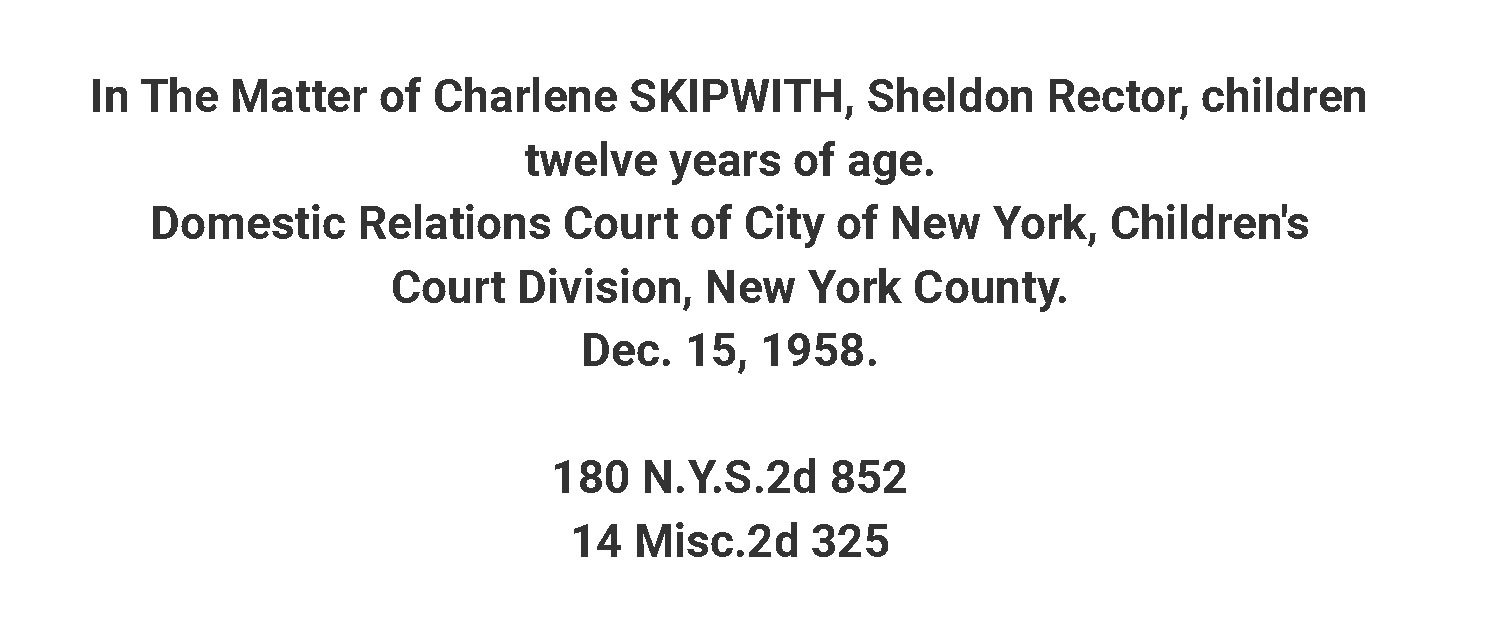In the matter of Charlene Skipwith, excerpt

Date: Dec 15, 1958
Caption: In re Matter of Charlene Skipwith, Sheldon Rector, Children Twelve Years of Age was a 1958 family court case in which the parents of children participating in the “Harlem Nine” boycott were charged with neglect by the Board of Education. The judge ruled in favor of the parents.
On October 28, 1958, in two separate cases, the Board of Education charged the “Harlem Nine” parents with violating the state law requiring parents to send their children to school. Judge Nathaniel Kaplan was the presiding family court judge in the case involving four of the parents. He found them guilty of violating the law.1 But less than two weeks later, two of the parents had their case heard by a different judge. Judge Justine Polier dismissed the charges against the parents in her courtroom.
During the trial, the parents explained that they had kept their children out of school because of the unequal conditions there. The parents presented data that documented the conditions in their schools. As the parents’ attorneys argued, these patterns were common in schools serving a majority of Black and Puerto Rican students in New York City, and much less common for schools serving white students.
In her opinion, Judge Polier agreed with the boycotting parents. She wrote that their children were receiving “inferior educational opportunities in those schools by reason of racial discrimination.” Therefore, she ruled that the parents were not in violation of the state’s compulsory education law. If the Board of Education provided unequal and discriminatory education in its schools, it could not require children to attend them.
Judge Polier repeated the Board’s assertion that the segregation in New York City schools was “de facto” in nature, the result of housing patterns and not the result of any wrongdoing on behalf of the Board. Nonetheless, she ruled that the Board had the legal responsibility to operate integrated schools and that they had the power to distribute qualified teachers fairly across the city’s schools.
After Judge Polier’s ruling, the Board of Education agreed to transfer the children of the “Harlem Nine” to different schools that their parents thought offered better opportunities. However, segregation continued for most children in Harlem schools.2
-
“4 Mothers Guilty in School Boycott,” The New York Times, December 4, 1958. ↩︎
-
Adina Back, “‘Exposing the ‘Whole Segregation Myth’: The Harlem Nine and New York City’s School Desegregation Battles,” in Freedom North: Black Freedom Struggles Outside the South, 1940-1980, ed. Jeanne Theoharis and Komozi Woodard (New York: Palgrave Macmillan, 2003), 65-91. ↩︎
Categories: K-12 organizing, community activism, parent activism"
Tags: racist segregation, policing and the criminal legal system, protest, zoning and student assignment, court cases
This item is part of "Mae Mallory and the “Harlem Nine”" in "Black and Latina Women’s Educational Activism"
Item Details
Date: Dec 15, 1958
Source: Matter of Skipwith, 14 Misc. 2d 325, 180 N.Y.S.2d 852 (N.Y. Dom. Rel. Ct. 1958)
Copyright: Government document
How to cite: “In the matter of Charlene Skipwith, excerpt,” in New York City Civil Rights History Project, Accessed: [Month Day, Year], https://nyccivilrightshistory.org/gallery/matter-of-skipwith.
Questions to Consider
- What evidence did the parents offer to show that their children’s schools were unequal?
- How did Judge Polier explain her decision in favor of the Harlem parents?
- Why did Judge Polier say that the Board of Education was responsible for desegregating schools?
References
How to Print this Page
- Press Ctrl + P or Cmd + P to open the print dialogue window.
- Under settings, choose "display headers and footers" if you want to print page numbers and the web address.
- Embedded PDF files will not print as part of the page. For best printing results, download the PDF and print from Adobe Reader or Preview.
